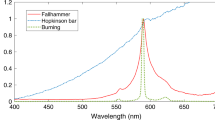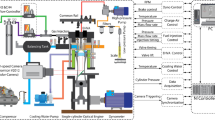Abstract
THE diffuse bands appearing very strongly in the flame spectra of the alkaline-earth metals have been identified as due to the hydroxide radicals, CaOH, SrOH and BaOH. This identification is based on the work of James and Sugden1 on hydrogen–air flames, employing photometric methods, and on work on isotope shifts with deuterium, which have been obtained for CaOH by Gaydon2 and for SrOH by Huldt and Lagerqvist3. The flame method has now been extended to the strong red and infra-red barium bands.
This is a preview of subscription content, access via your institution
Access options
Subscribe to this journal
Receive 51 print issues and online access
$199.00 per year
only $3.90 per issue
Buy this article
- Purchase on Springer Link
- Instant access to full article PDF
Prices may be subject to local taxes which are calculated during checkout
Similar content being viewed by others
References
James, C. G., and Sugden, T. M., Nature, 175, 333 (1955).
Gaydon, A. G., Proc. Roy. Soc., A, 231, 437 (1955).
Huldt, L., and Lagerqvist, A., Naturwiss., 42, 365 (1955).
Pearse, R. W. B., and Gaydon, A. G., “The Identification of Molecular Spectra” (2nd edit., Chapman and Hall, London, 1950).
James, C. G., and Sugden, T. M., Nature, 171, 428 (1953).
Author information
Authors and Affiliations
Rights and permissions
About this article
Cite this article
BULEWICZ, E. Flame Spectrum of Barium: Red and Infra-Red Bands. Nature 177, 670–671 (1956). https://doi.org/10.1038/177670a0
Issue Date:
DOI: https://doi.org/10.1038/177670a0
Comments
By submitting a comment you agree to abide by our Terms and Community Guidelines. If you find something abusive or that does not comply with our terms or guidelines please flag it as inappropriate.



